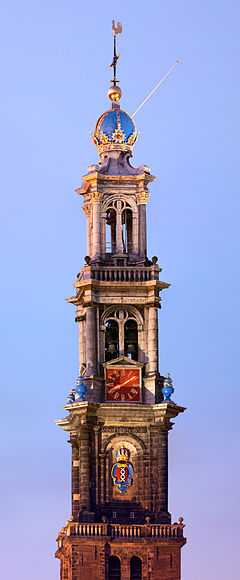Westerkerk
| Westerkerk | |
|---|---|

Amsterdam Westerkerk | |
| Basic information | |
| Location | Amsterdam, Netherlands |
| Geographic coordinates | 52°22′28″N 4°53′1″E / 52.37444°N 4.88361°ECoordinates: 52°22′28″N 4°53′1″E / 52.37444°N 4.88361°E |
| Affiliation | Protestant Church in the Netherlands |
| Rite | Protestant |
| Ecclesiastical or organizational status | Parish church |
| Website | www.westerkerk.nl |
| Architectural description | |
| Architect(s) | Hendrick de Keyser |
| Architectural style | Dutch Renaissance |
| Completed | 1631 |
| Specifications | |
Westerkerk ("Western church") is a Dutch Protestant church in central Amsterdam. It is next to Amsterdam's Jordaan district, on the bank of the Prinsengracht canal.
History
Several older churches in Amsterdam, such as Oude Kerk and Nieuwe Kerk, were originally built by Roman Catholics and were converted to Protestantism during the Reformation in 1578. The Westerkerk was one of the first purposely built Protestant churches. The Noorderkerk and Zuiderkerk preceded the Westerkerk. Today the Westerkerk remains the largest church in the Netherlands that was built for Protestants.
The Westerkerk was built in 1620-1631 after a design by the late Renaissance architect Hendrick de Keyser [1] in the Dutch Renaissance style and in the form of a patriarchal cross.
The spire, called the Westertoren ("Western tower"), is the highest church tower in Amsterdam, at 85 meters (279 feet). The crown topping the spire is the Imperial Crown of Austria of Maximilian I.[2] The church bells were made by François Hemony in 1648.[3]
Rembrandt van Rijn was buried in the Westerkerk[1] on October 8, 1669. The exact location of the grave is unknown, but presumed to be somewhere along the northern wall.[1] Rembrandt's lover Hendrickje Stoffels is also buried here, as is Rembrandt's son Titus van Rijn.[1] Other painters buried in the Westerkerk are Nicolaes Berchem, Gillis d'Hondecoeter, Melchior d'Hondecoeter and Govert Flinck. The church organ is decorated with doors painted by Gerard de Lairesse.
The Westerkerk is located close to the Achterhuis (now Anne Frank House) where diarist Anne Frank, her family and others hid from Nazi persecution for two years during World War II. The Westerkerk is mentioned frequently in her diary - its clock tower could be seen from the attic of the Achterhuis and Anne Frank described the chiming of the clock as a source of comfort. A memorial statue of Frank is located outside the church.
On March 10, 1966, Princess Beatrix married Prince Claus in the Westerkerk.
Church organ
There was no organ when the Westerkerk was consecrated on Whit Sunday in 1631. According to Calvinism, playing instrumental music inside the church was still considered 'popish' in those days. It took many years of consultation until an organ was finally allowed. At first there was still talk of moving the organ used in the Oude Kerk or the Zuiderkerk, but in 1681 the Westerkerk decided on commissioning organ builder Roelof Barentszn Duyschot for the construction of a new organ. The organ was named after its builder.
On Christmas Day in 1686, Jurriaan Bouff from Leiden was the first person to play the organ during a church service. He used to play three times on every Sunday (in those days, as many as four church services were held on a Sunday). He would also play on Thursdays and Fridays, as well as on days of thanksgiving and prayer.
The organ panels were made by Gerard de Lairesse. De Lairesse was born in Liège in 1640 and he moved to the Netherlands in 1664. In the second half of the 17th Century, he was one of the most popular painters in the Netherlands.
Photo gallery
| Wikimedia Commons has media related to West Church. |
-

Westertoren
-
Organ and ceiling of the Westerkerk
-

The church organ
-
Westerkerk organ panels, by Gerard de Lairesse
-
A commemorative plaque of the singer Willy Alberti by Hans Bayens, placed against the Westertoren
-

View of the Jordaan from the church tower
-

The Prinsengracht by night, with a view of the Westerkerk and Anne Frank House
-

Interior of the Westerkerk
-
Statue of Anne Frank on the church square, by Mari Andriessen
-

Homomonument on the church square
-
Pulpit and altar of the Westerkerk
-
The Burning Bush in the Westerkerk
-
Epitaph inside the Westerkerk
| |
Dutch Rijksmonument 4298 |
References
- ↑ 1.0 1.1 1.2 1.3 Martin Dunford (2010). The Rough Guide to The Netherlands. Penguin. pp. 72–73. ISBN 978-1-84836-882-8.
- ↑ "The Westerkerk". Rough Guides. Retrieved 12 March 2011.
- ↑ Rijksmonument report






